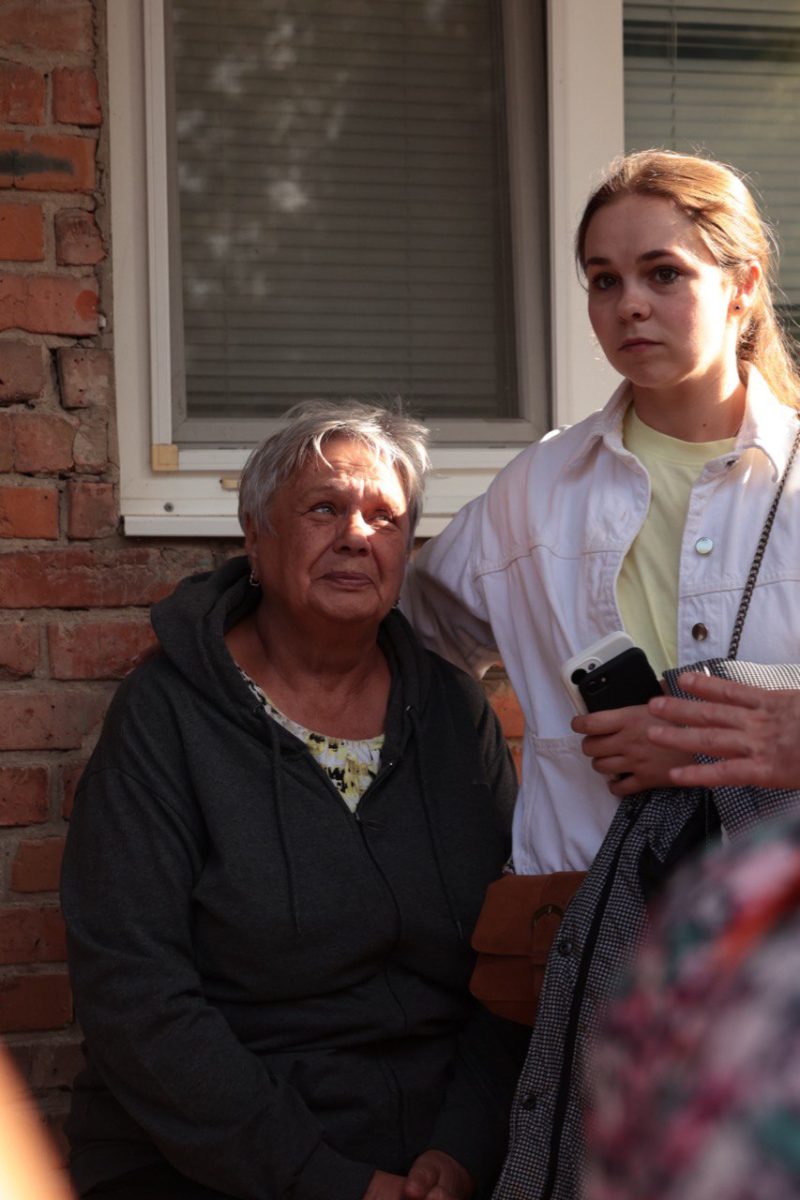September 10 — Vinnytsia by Night, Kramatorsk by Morning
In the dark hours of September 10, 2025, a wave of 26 Shahed drones and 11 cruise missiles ripped across the Vinnytsia region. Between midnight and dawn, they gutted roofs, shattered windows, and tore through more than 30 homes. Fires raged as 81 emergency workers fought through the night.
Galina, a resident, remembered the instant her house was ripped apart:
“It was around two o’clock. These Shaheds came screeching. Two rockets hit, everything flew out. Glass scattered everywhere. My bed is covered in glass. But I wasn’t in it.”
Viktoria Fedorivna Prishchepa recalled suffocating smoke pouring in after impact:
“This rocket exploded silently. Doors torn out, windows gone. My daughter said, let’s go, because we’ll suffocate.”
Kateryna Dakhnovska pointed to her terrified children:
“The first explosion near us. Very heavy. We are nervous, and the children are very frightened. No one has spoken with us yet — only SES recorded the damage.”
By dawn, Mayor Serhii Morhunov was on site, consoling families and promising support:
“Don’t be nervous. The most important thing is health. We must be strong, and we will help with everything. We’ll do everything.”
Later, Nataliia Zabolotna, First Deputy Head of the Regional Administration, confirmed the toll had grown:
“Unfortunately, we already have two injured. Another woman has an acoustic trauma… The damage is significant: roofs, cracks, windows blown out.”
Only hours later, the war shifted east. On the morning of September 10, Kramatorsk came under attack. A wave of Shahed drones struck the central square, private homes, and a five-story residential building, injuring an elderly woman.
Natalia, a resident, described the aftermath:
“The whole house is covered in glass. I thought the sky had exploded.”
Police spokesman Pavlo Dyachenko confirmed the emergency response:
“Police medics assisted an elderly woman. Officers are inspecting apartments, rescuing people trapped. These are fragments of the enemy drone, this is the crater left by the impact.”
One day. Two cities. A night raid followed by a morning strike. This cadence was not exceptional. It was the pattern.

The Summer of Escalation
The September 10 attacks were not an anomaly. They capped a summer of strikes that had already shown the rhythm of destruction.
July 31 — Kyiv (overnight/pre-dawn)
Missiles and drones hammered the capital overnight, killing 11–16 civilians and injuring 88–132. Among the dead was a six-year-old boy. Russia’s Ministry of Defense claimed it had struck “airfields and ammo depots.” In reality, children were pulled from residential blocks and hospitals.
August 18 — Kharkiv (pre-dawn)
At 05:00, a five-storey apartment block was struck. At least five civilians killed, including two children. Survivors described dragging kids out barefoot, still tangled in blankets. Natalia, a resident, cried:
“It flew everywhere, I can’t clean up the glass, the whole house is covered in glass. I thought the sky had exploded. Oh, righteous God. Oh God, God, how long are you going to keep hitting us, you beast.”
August 28 — Kyiv (overnight)
Missiles and drones fell on the capital again in one of the deadliest overnight attacks of the year. Russia claimed it struck “air bases and military-industrial enterprises.” The UN Human Rights Monitoring Mission verified at least 18 civilians killed, including four children, and 38–64 injured. Among the damaged buildings were the EU’s Ukraine office and the British Council.
August 30 — Zaporizhzhia (overnight)
Russia boasted of hitting “military enterprises and airbases.” Instead, at least one person killed, 24–30 civilians injured (including children), and entire residential blocks and energy infrastructure gutted.
September 3 — Kostiantynivka (late morning)
Between 10:30 and 11:50 a.m., artillery and drones pummeled the central market. Nine civilians died, seven were wounded. Witnesses described mothers sprawled across toppled vegetables, lifeless bodies pressed into the street’s dust.
Though earlier in the year, Kryvyi Rih’s April 4 strike foreshadowed the pattern. A missile landed near a playground and restaurants just before 19:00, killing 20 civilians, including 9 children. Parents died shielding their kids.
The Propaganda Script
Moscow’s narrative is formulaic. Each time, the Ministry of Defense claims strikes on “airfields,” “military-industrial enterprises,” “temporary deployments.” Headlines repeat “all objectives hit.”
- Kyiv, July 31: “Airfields and ammo depots.” Fact: children killed in homes and hospitals.
- Kyiv, August 28: “Air bases and MIC targets.” Fact: 18 dead, four children, EU offices shattered.
- Zaporizhzhia, August 30: “Military enterprises and airbases.” Fact: residential homes and children injured.
- Kryvyi Rih, April 4: “Only military targets.” Fact: nine children at a playground.
- Mukachevo, August 21: “Military-industrial complex.” Fact: a Flex civilian electronics plant, 15–23 workers injured.
The script is a shield. The facts, corroborated by OHCHR, UNICEF, Reuters, AP, show deliberate civilian harm.

The Three-Minute Window
The September 10 attacks exposed the brutal arithmetic. In Vinnytsia, Shaheds tore into homes around 02:00 a.m. In Kramatorsk, drones detonated in the morning, one captured on film exploding as a mother whispered comfort to her child. Civilians had no more than three minutes from alert to impact.
- In Kryvyi Rih, no warning preceded the 19:00 playground blast.
- In Kharkiv, children died at 05:00 in their beds.
- In Kyiv, overnight salvos detonated before families could register the sirens.
Potential Prevention measures:
- Schools & churches: Pre-open basements; usher children instantly.
- Factories: Stagger shifts away from 06:00 and 19:00; 90-second muster drills.
- Residential: Differentiate pre-dawn sirens.
- Transport hubs: Metro stations staffed overnight.
Children cannot outrun a missile. But they can survive if the doors are already open.
Historical Echoes
“All objectives hit” is not new. It was the line in Grozny, 1999, when Russia claimed to strike “only rebel positions” as apartment blocks collapsed. It was the line in Aleppo, 2016, as hospitals and schools fell under bombs labeled “terrorist infrastructure.” It echoes the language of World War II firebombings, when civilians were erased under the phrase “strategic necessity.”
The difference now is the evidence; timestamps, survivor voices, independent verification.
The evidence is irrefutable:
- Strikes align with civilian rhythms, not military necessity.
- Russian MoD claims are scripted, contradicted by facts.
- Children are the casualties, over and over.
The cadence is deliberate. The script is rehearsed. The dead are real.
Children cannot survive in three minutes. The only question is whether the world will give them more time.
All information in this report has been verified and sourced by the Center for International Communications of Ukraine (CIDEIPS) , provided to Truthlytics for documentation and public record.





